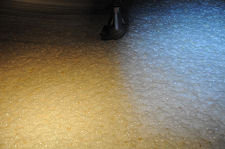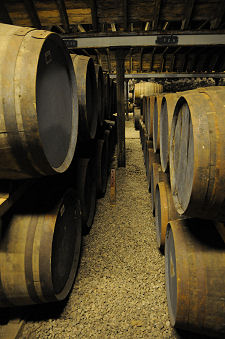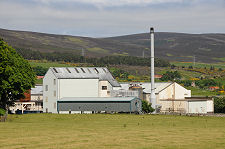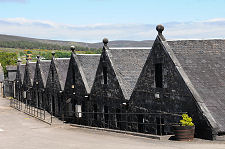 Clynelish Distillery |
Clynelish Distillery stands on gently rising ground a short distance clear of the northern edge of the village Brora and its glass-fronted still room offers wide views to the north-east.
Access to the distillery is via a minor road that turns off the A9 a little to the north of Brora. Signs direct you to the visitors' car park and from there you proceed to the visitor reception and shop.
From the car park you immediately become aware of one of the most fascinating aspects of a visit to Clynelish: there is not one distillery here but two. One of them is formed by a large and fairly modern industrial complex uphill from the car park, which includes the glass fronted still room you will doubtless have seen as you approached along the minor road. This is Clynelish Distillery. The second is the obviously much older complex to the north of the car park and new distillery. This is Brora Distillery, which used to be known as Clynelish Distillery and was disused for nearly four decades between being mothballed in 1983 and resuming production in 2021. (Continues below image...)
 Brora Distillery Before Its Reopening |
Clynelish Distillery - the original Clynelish Distillery - dates back to 1819. The 1st Marquess of Stafford (who later became the 1st Duke of Sutherland) and his wife Elizabeth, 19th Countess of Sutherland, owned vast estates that comprised much of modern Sutherland. Agricultural output of the fertile areas was steadily improving and barley was being produced in increasing quantities. The Sutherlands wanted to add value to their agricultural output, and one obvious way of doing so was to turn some of it into Scotch whisky. Brora was chosen as the location for their new distillery because it was fairly well placed for the main barley growing areas: and especially because it was close to Brora colliery, also owned by the Sutherland estate, and it was hoped that the local coal could be used to heat the stills. The total cost of the original distillery was £750.
Clynelish Distillery was visited by the author Alfred Barnard during the tour of Scottish distilleries he undertook between 1885 and 1887. The book he subsequently produced devotes two pages to Clynelish. After complaining about the three hour train journey south from Halkirk, where he had visited Gerston Distillery (which closed in 1911) he embarks on a visitor guide to Dunrobin Castle, the home of the Sutherlands, before finally turning his attention to the distillery half way through his allotted space.
From his description it would appear that the old distillery you see today has changed little since his visit. What is interesting is his comment that the quality of the coal being produced by the mine at Brora was no longer good enough to power the distillery. He also suggests that Clynelish "Highland Malt" was highly sought after. Production at the time was 20,000 gallons per year and demand outstripped supply to the point that trade orders were routinely turned down.
A completely new and much larger distillery was opened on a site just to the south of the existing distillery in 1967/8 by the then owners, Scottish Malt Distillers Ltd. This took on the name of Clynelish Distillery. The old distillery then closed. It reopened in 1969 under the name Brora Distillery, producing a peaty malt. It closed again in 1983, to be reopened, as already noted, in 2021.
Visitors to Clynelish Distillery begin in the reception and shop. Availability of land was clearly not an issue when the distillery was being built and the result is some large interior spaces and production areas that allow plenty of room in which to work. The first major venue is the hangar-like room in which you find the attractive copper mash tun and eight large Oregon pine washbacks. Two more stainless steel washbacks are in what looks like an extension at one end of the area. The whole process is controlled from an electronic console in one corner.
The heart of Clynelish Distillery, as it is of any distillery, is the still room. The still room at Clynelish is large and extremely impressive. Most of the front wall and one side wall are glazed and the result is a brightly lit cathedral-like space. Within it the distillery's six stills are lined up, with the three wash stills at one end and the three spirit stills at the other. Unusually at Clynelish the spirit stills are larger than the wash stills: normally it is the other way around. The condensers are also housed in the still room and the main walkway through the room leads between the stills on one side and the condensers on the other, and under the six lyne arms which pass high above your head.
This is distilling on an industrial scale and in a modern setting, and the effect is impressive and very striking. There are two spirit safes centrally placed within the still room, one for the wash and the other for the spirit, both made by Abercrombie of Alloa in 1967.
 Inside the Still Room |

|
|
|
Visitor InformationView Location on Map4 Star Visitor Attraction. Brora, Sutherland, KW9 6LR. Tel: 01408 623000. clynelish.distillery@diageo.com Grid Ref: ND 159 295 Distillery Web Page Opening Hours Tours & Admission What3Words Location: ///formally.though.verbs |
 The Mash Tun |
 Washbacks |
 Inside a Washback |
 Testing a Sample |
 Hatch on a Spirit Still |
 One of the Spirit Safes |
 Stills |
 Inside the Bonded Warehouse |
 Inside the Bonded Warehouse |









